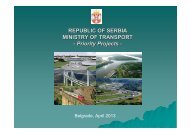Innovation Canada: A Call to Action
Innovation Canada: A Call to Action
Innovation Canada: A Call to Action
You also want an ePaper? Increase the reach of your titles
YUMPU automatically turns print PDFs into web optimized ePapers that Google loves.
Program Mix and DesignChapterProgram Mixand Design6This chapter addresses the second question inthe government’s charge <strong>to</strong> the Panel: “Is thecurrent mix and design of tax incentives anddirect support for business research anddevelopment (R&D) and business-focussedR&D appropriate?”In its forthcoming report on business innovationpolicies, the Organisation for EconomicCo-operation and Development (OECD)emphasizes the importance of striking the rightbalance in the mix of programs <strong>to</strong> supportbusiness innovation. It notes, for example, therequirement <strong>to</strong> have a set of instruments that issufficiently differentiated <strong>to</strong> meet the needs ofcomplex innovations systems while at the sametime avoiding the inefficiencies of operating <strong>to</strong>omany schemes at <strong>to</strong>o small a scale — an issuethat was addressed in the previous chapter.The mix between direct and indirect measuresis another important consideration, notablybecause each form of support offers certainadvantages and disadvantages (Box 6.1).In its State of the Nation reports, the ScienceTechnology and <strong>Innovation</strong> Council (STIC 2009,2010) notes that, as a percentage of grossdomestic product (GDP), government supportfor business R&D in <strong>Canada</strong> is among the mostgenerous in the world, but underscores that,relative <strong>to</strong> compara<strong>to</strong>r countries, <strong>Canada</strong>’ssupport is heavily weighted <strong>to</strong>ward taxincentives as opposed <strong>to</strong> direct supportmeasures. Of particular note, as seen inFigure 6.1, the United States (US) spendssignificantly more on direct support measuresrelative <strong>to</strong> support through tax incentives.However, there is a trend among OECDcountries <strong>to</strong> make greater use of R&D taxincentives (OECD forthcoming).The Panel has concluded that the OECD data inFigure 6.1 <strong>to</strong> some extent overstate federalreliance on indirect support because (i) thesedata do not capture the full range of directprograms in <strong>Canada</strong> and (ii) the measuremen<strong>to</strong>f direct support varies across countries, makinginternational comparisons problematic.Specifically, the Panel’s mandate includessupport not only for “direct governmentfunding of business expenditure on researchand development (BERD),” as depicted inFigure 6.1, but also for commercially relevantR&D performed by public and non-profitinstitutions — for example, support throughprograms that seek <strong>to</strong> help build links betweenacademia and industry. The addition of theseexpenditures <strong>to</strong> the “direct” support mix wouldslightly increase <strong>Canada</strong>’s ratio of direct <strong>to</strong>indirect support relative <strong>to</strong> the picture inFigure 6.1. There are also differences amongcountries in the calculation of certain items ofdirect government support that have the effec<strong>to</strong>f increasing the reported direct expendituresof some countries relative <strong>to</strong> <strong>Canada</strong> — forexample, their inclusion of loans <strong>to</strong> business andgovernment procurement of R&D services asdirect support measures. It should also be notedthat the refundable Scientific Research andExperimental Development (SR&ED) tax credit is6-1
















